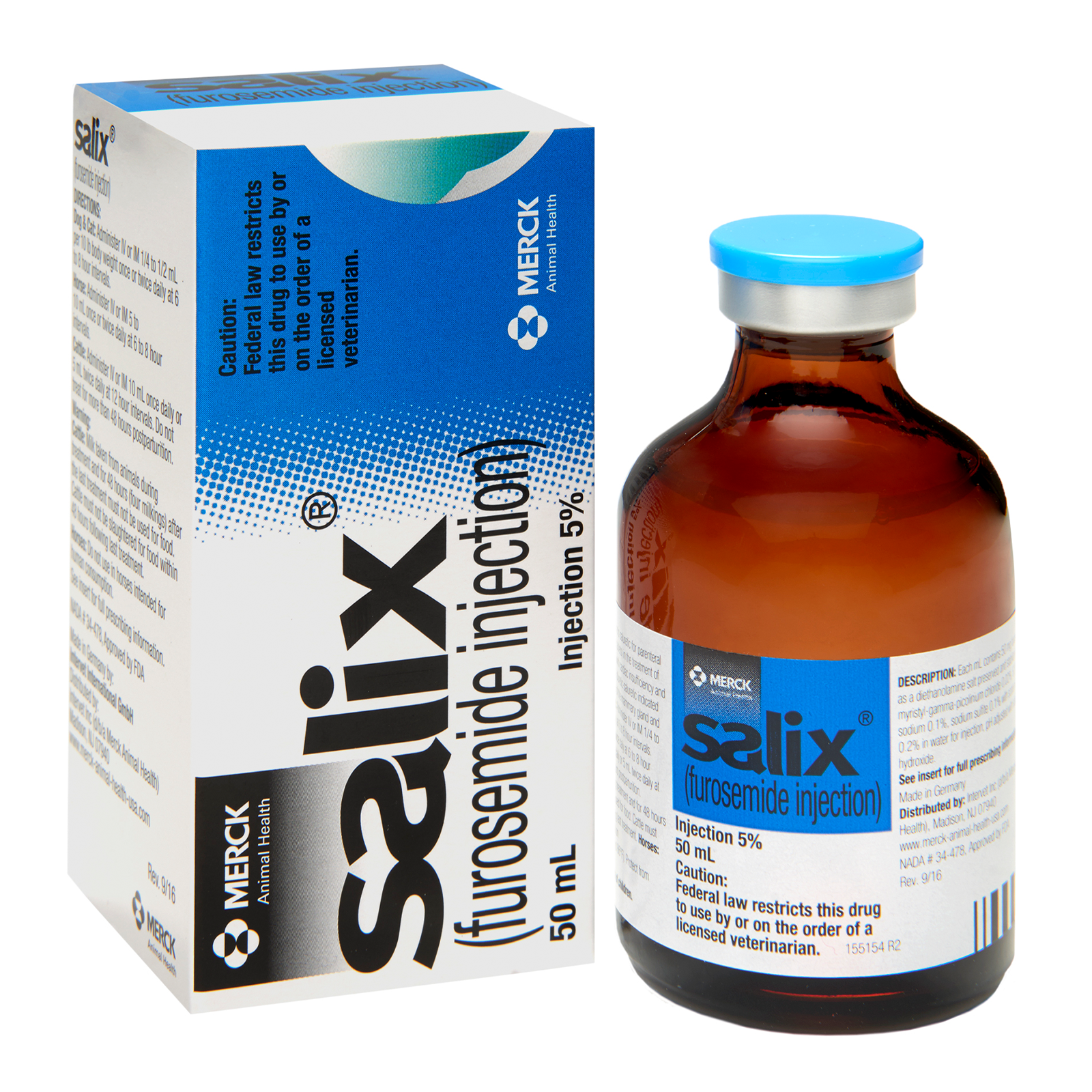Description
Salix (furosemide injection) is a diuretic-saluretic for prompt relief of edema associated with cardiac insufficiency and acute noninflammatory tissue edema.
SALIX is a highly effective diuretic-saluretic which if given in excessive amounts may result in dehydration and electrolyte imbalance, enhancing the risk of circulatory collapse, thrombosis, and embolism. The animal should be observed for early signs of fluid depletion with electrolyte imbalance, and corrective measures should be administered. See package insert for full information regarding contraindications, warnings, and precautions. SALIX may lower serum calcium levels and cause tetany in rare cases of animals having an existing hypocalcemic tendency. Do not use in horses intended for human consumption.
Indications
SALIX is indicated for the treatment of peripheral edema, (pulmonary congestion, ascites) associated with cardiac insufficiency and acute noninflammatory tissue edema.
It is an effective diuretic possessing a wide therapeutic range. Pharmacologically it promotes the rapid removal of abnormally retained extracellular fluids.
The rationale for the efficacious use of diuretic therapy is determined by the clinical pathology producing the edema.
The continued use of heart stimulants, such as digitalis or its glycosides, is indicated in cases of edema involving cardiac insufficiency.
Administration
Dose
For the horse, the individual dose is 250 mg to 500 mg (5 to 10 mL) administered intramuscularly or intravenously once or twice daily at 6 to 8 hour intervals until desired results are achieved. The veterinarian should evaluate the degree of edema present and adjust dosage schedule accordingly. Do not use in horses intended for human consumption.
The dosage should be adjusted to the individual’s response. In severe edematous or refractory cases, the dose may be doubled or increased by increments of 1 mg per pound body weight. The established effective dose should be administered once or twice daily. The daily schedule of administration can be timed to control the period of micturition for the convenience of the client or veterinarian. Mobilization of the edema may be most efficiently and safely accomplished by utilizing an intermittent daily dosage schedule, i.e., every other day or 2 to 4 consecutive days weekly.
The solution is acceptable for use when clear, colorless to pale yellow to pale brown. Do not use this solution if it appears discolored. Do not puncture the stopper more than 32 times.
Precautions and Contraindications
SALIX is a highly effective diuretic-saluretic which if given in excessive amounts may result in dehydration and electrolyte imbalance. Therefore, the dosage and schedule may have to be adjusted to the patient’s needs.
The animal should be observed for early signs of electrolyte imbalance, and corrective measures administered. Early signs of electrolyte imbalance are: increased thirst, lethargy, drowsiness or restlessness, fatigue, oliguria, gastrointestinal disturbances and tachycardia. Special attention should be given to potassium levels.
SALIX may lower serum calcium levels and cause tetany in rare cases of animals having an existing hypocalcemic tendency. Although diabetes mellitus is a rarely reported disease in animals, active or latent diabetes mellitus may on rare occasions be exacerbated by SALIX.
While it has not been reported in animals the use of high doses of salicylates, as in rheumatic diseases, in conjunction with SALIX may result in salicylate toxicity because of competition for renal excretory sites. Transient loss of auditory capacity has been experimentally produced in cats following intravenous injection of excessive doses of SALIX at a very rapid rate.
Electrolyte balance should be monitored prior to surgery in patients receiving SALIX. Imbalances must be corrected by administration of suitable fluid therapy. SALIX is contraindicated in anuria. Therapy should be discontinued in cases of progressive renal disease if increasing azotemia and oliguria occur during the treatment. Sudden alterations of fluid and electrolyte imbalance in an animal with cirrhosis may precipitate hepatic coma, therefore observation during period of therapy is necessary.
In hepatic coma and in states of electrolyte depletion, therapy should not be instituted until the basic condition is improved or corrected. Potassium supplementation may be necessary in cases routinely treated with potassium-depleting steroids.







Reviews
There are no reviews yet.